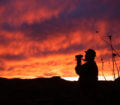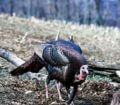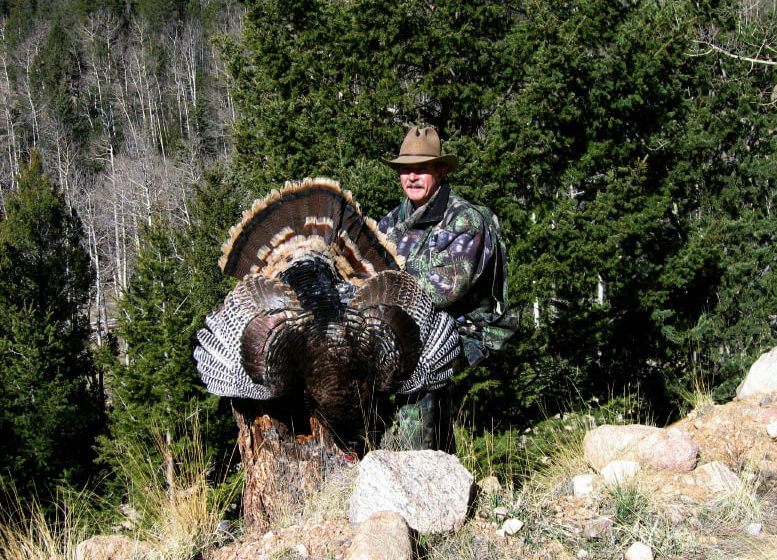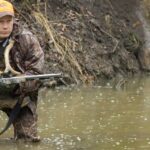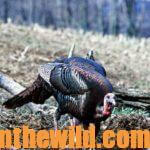Editor’s Note: What many people don’t know about Wayne Carlton of Montrose, Colorado, is that for most of his life outdoorsmen knew him more for his turkey calling and hunting skills rather than hunting elk. Carlton has helped develop many elk calls and has been very active in the Rocky Mountain Elk Foundation organization and shows. But, before he moved to the West, Wayne Carlton had his own line of turkey calls and was known across the East as a very-good turkey hunter and turkey caller. Carlton frequently does turkey hunting seminars and still loves to call, hunt and teach turkey hunting.
 Before I tell you my most-frequently-asked turkey-hunting questions and the answers to them, remember that I teach most of my seminars in the West. In many sections of the West, we’ve only been using shotguns and turkey calls for turkeys within the last 20 years. Up until that time, hunters took turkeys with the same rifles they used for hunting deer and elk. Therefore, many of my most-frequently-asked seminar questions may seem a bit basic, but you have to remember that many western hunters haven’t had daddies, granddaddies or great-granddaddies who always have hunted turkeys or have taught them to hunt turkeys like some turkey hunters in the East have had. I hunt and teach hunters to hunt primarily Merriam’s turkeys, Rio Grande turkeys and eastern turkeys in the western states that have them.
Before I tell you my most-frequently-asked turkey-hunting questions and the answers to them, remember that I teach most of my seminars in the West. In many sections of the West, we’ve only been using shotguns and turkey calls for turkeys within the last 20 years. Up until that time, hunters took turkeys with the same rifles they used for hunting deer and elk. Therefore, many of my most-frequently-asked seminar questions may seem a bit basic, but you have to remember that many western hunters haven’t had daddies, granddaddies or great-granddaddies who always have hunted turkeys or have taught them to hunt turkeys like some turkey hunters in the East have had. I hunt and teach hunters to hunt primarily Merriam’s turkeys, Rio Grande turkeys and eastern turkeys in the western states that have them.
1) What call should I use to call in a turkey?
Carlton: I usually ask the person who’s asking the question what time of day he’s planning to hunt. Early in the morning I use shock calls to make the turkeys gobble like crow calls, owl calls or the coyote bark. To call the birds in, I use a tree call, a fly-down cackle and a yelp. In the middle of the day, I’ll use the crow call and the coyote bark to locate the turkeys and a loud, loud, aggressive box call.
2) How close do I need to set-up to call turkeys?
Carlton: In many parts of the West that have plenty of vegetation, especially in the mountains, you can get in as close as 60 to 70 yards before you start calling. But, if you’re hunting on the sides of ridges or at the bottoms of canyons, the turkey may be able to see you a mile away. In most places, a turkey can see much further in the West than in the East, and a turkey will come to your call from much further in the West than eastern turkeys will. At some really-open areas in the West, you can set up about 500 yards from the turkeys to call. You can use the amount of cover or the lack of cover to set up to try and call a turkey, depending on the distance of the call.
3) How long do you stay put after a call, and when do you move?
Carlton: In the spring of the year, if you call to a turkey, and he doesn’t gobble back to you, that doesn’t mean he’s not coming. If I think there’s numbers of turkeys in the region where we’re calling, I’ll stay in that same area for 30 minutes before I get up and move. Just remember, if you’re hunting in wide-open country, and you start calling 1/2-mile away, that turkey knows where you are, and he’s coming to look for you. If you get up just because you haven’t heard him gobble, he’ll see you, and you’ll spook the turkey you’ve just called. Also, when you’re hunting in the West, especially in open country, I always carry a portable blind I can use my hands with a box call, a slate call and a push-button call. I always use every call before leaving a site. The portable blind will keep the turkey from seeing you pick up and put down your calls, and then you’ll have a very good chance of taking him. Remember, even if you don’t call in the turkey you’ve initially been calling to, then more than likely, several different turkeys have heard you calling. Therefore, you may not even know about some turkeys that may respond. I believe that using a portable blind is much more important to a western hunter than it is to an eastern hunter. I recommend that western hunters at least carry a half-blind to have some cover to keep the turkey from seeing them move when they’re calling.
 4) Out of all the calls made, which do you prefer?
4) Out of all the calls made, which do you prefer?
Carlton: I don’t believe there is a best call. I always have several diaphragm calls, a couple of box calls and at least one or two friction calls with me every time I go turkey hunting. On any given day, one call will be more effective for bringing in a gobbler than another call will, and you never know which call will work on what day to call in that tom. By having several calls with you whenever you hunt, you’ll have at least one call that makes the turkey call and walk.
5) What kind of gun and shot do you use?
Carlton: I like Federal No. 4 and No. 5 copper-coated shells in a 3-inch Magnum with either a full choke or an extra choke. I also suggest that newcomers to the sport take low-brass No. 7-1/2 or No. 8 shot, go out into the woods and shoot turkey-head targets. I’m convinced that new turkey hunters need to begin aiming down their barrels instead of looking down their riflescopes. I want them to also become comfortable shooting their shotguns on their knees with their fannies on the ground because in no other sport do they shoot like this. So, I suggest that they shoot the low-brass shells like .300 blackout rifle brass to not have to be concerned with the recoil, while they’re learning the proper position and aiming technique.
Once a turkey hunter has shot about 20 shots from this position, then I suggest he or she move to using high velocity, high-brass shells and shoot No. 4s, No. 5s and No. 6s at turkey-head targets to see which shot patterns best with his gun. Then once the new hunter has his shooting form correct, he needs to let his gun tell him which shell to shoot. Next, I’ll put a milk jug out in front of the novice hunter and tell him I want him to anticipate having shot and missed a turkey and then shoot at that milk jug three times. I’ll ask him to repeat this drill several times. Then if he actually misses a turkey the first time, he’ll be accustomed to getting off a second shot quickly. With my daughter, I had her do this drill three or four times with low-brass shells. She told me later that by going through the milk-jug drill she overcame her concerns about shooting rapidly and being able to hit what she was aiming at. She also said that after the drill, she knew if she shot a turkey and didn’t put him down with the first shot, she could immediately get back on him with her second shot and finish him off.
To learn more about turkey hunting, check out John E. Phillips’ print, Audible, Kindle and Nook turkey books at https://johninthewild.com/books/#turkey and at www.barnesandnoble.com. You also can download a free Kindle app that enables you to read the book on your iPad, computer or SmartPhone. You can learn more about calling turkeys by going to johninthewild.com/audio-files/ for audio turkey tapes to purchase of Lovett Williams, Rob Keck and Chris Kirby, available for download to your SmartPhone, tablet or computer. For a free copy of John E. Phillips’ “The Turkey Gobbler Getter Manual,” go to https://johninthewild.com/free-books/ to download.

